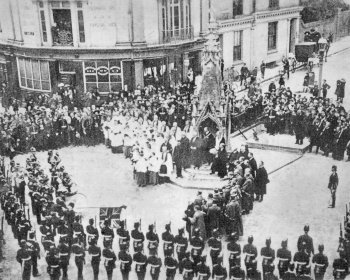Winchester from Cathedral to Castle
Description Part 1

F.W. Holdaway and Son, had No.18 as a large scale Caterer. The old-established firm proudly advertised their achievement in providing "simultaneous teas for 3750 at the opening of Winchester College War Memorial cloisters".
The 15th century High Cross was restored in 1865. The only original statue, of St John, is on the south side.
The Pentice, the term means a "long covered walk supported by columns", was referred to in 1880 directories as the Piazza. The shelter provided is certainly appreciated but the varied painted supports are unattractive.
The photograph shows loyal citizens and dignitaries of the city celebrating the diamond jubilee of Queen Victoria in 1897. It looks as if the total population of 10,000 were in the High Street.
The 18th century apothecary's house, later the London and Smith's Bank (and now the National Westminster Bank) shows a brave floral display at upper floor level. The present occupants have not adopted this idea and indeed have upset the serenity of this Georgian house by inserting mirror glass in the upper windows.
No. 34, on the site of the old Edinburgh Castle Public House was, from 1871, used by Fosters the Tobacconist. The shop fittings were removed in 1980 and re-assembled in the City Museum.
No 41. at the end of the Pentice is a well restored timber frame building near to the area referred to as "hell", possibly because, centuries ago, the Royal Mint belched forth smoke and flames.
The unfailing popularity of timber used as "black and white" decoration is seen at Nos. 35-38 which also includes carvings of four historical Winchester characters.
No.45 was Hunt's dispensing "chymists", one of three in the High Street. In addition to supplying oxygen and batteries on hire, they would undertake minor dental operations. This shop was also re-assembled in the City Museum in 1980 having been in the Piazza since 1861.

The photograph shows the frontage at No.48 of J. Kaines Butcher and Poulterer who had another shop at No.124. He advertised that "hams killed and cured on the premises had no preservatives or chemicals".
An analysis of the occupation of premises in the High Street, particularly over the last hundred years, mirrors the social and economic factors prevailing at the time.
In the 1880's the business would be managed by a family living over the shop. There was great variety both in the shop itself and what could be bought in the street. At this time there were eight Tailors and Drapers, six Grocers and Bakers, two Fishmongers, three Bootmakers and two Saddlers. The three Chemists could offer homeopathy and of course the shilling bottle of linctus which purported to cure all ills.
Today the family business has gone and with it the individual presentation and personal attention.
The fierce competition between shops extends to Banks, Building Societies and Estate Agents. There are five national Banks and a similar number of Building Societies and as Hampshire is popular for working and living most of these firms are expanding.
In 1976 Winchester City issued guide lines on signs and Shop Fronts to advise shop-keepers on how to maintain some of the pleasant features of this street.
In 1986 another publication "Advertisements and the law" was published in co-operation with the Incorporated Chamber of Commerce. In particular it is hoped to control the extent of window stickers to 10%-15% of the window area.

This photograph is of the old Black Swan Hotel at the corner of Southgate Street, with the George Hotel at the junction with Jewry Street.
In the 19th century hotels arranged for "an omnibus" to meet trains at the recently opened Railway Station (1838) and the Black Swan was also the terminus for four road wagon services.
The point duty policeman was replaced by automatic traffic lights in 1934.
The Exchange Public House across Southgate Street was taken by the Black Swan proprietor, Charles Sherry, and his Hotel was auctioned in London in 1932, being demolished two years later. It was possible to get a first mortgage for £4500. The replacement building of shops and offices is an indifferent architectural answer on such an important corner site.
Noticeable on the south side was the Dolphin Hotel at No.51.
In 1785 two chamber maids from the George Hotel took over the Dolphin providing "a good `ordinary' every market day". This attractive corner building, the ground landlords being St. John's Hospital was, in 1984, sensitively refurbished as shops and offices by the Winchester architects Plincke Leaman and Browning.
Lloyds Bank at Nos. 48-50 is to be re-arranged and the old shop at No. 48 will revert to shop premises.
No. 57 Jacob and Johnson have published the Hampshire Chronicle since 1778. The façade with old bow windows is attractive as is the seasonal flower display above.

The Westgate dates from the 13th century with a rebuilt west front of 1390 and it was used as a prison in the 17th century.
There was a "smoking room" above the Westgate in the 1880's as an integral part of the Westgate Hotel and Tavern. On the north side of the street was the Plume of Feathers Public House.
The re-sited Westgate Hotel across Romsey Road is an attractive Greek revival design on a well-defined rounded corner. The photograph shows the throng assembled in front of the Hotel to mark the accession of George V in 1910. The Littlehales Memorial drinking fountain of 1880 is now at Oram's Arbor.
